How To Clean Ruby Rings? Learning this is the key to maintaining its fiery brilliance. Dirt, oil, and residue can cloud the gemstone’s beauty, making regular cleaning essential. With the right method, you can safely restore your ruby’s glow without risking damage.
Table Of Contents
- 1) The Safest Way to Clean a Ruby Ring at Home
- 2) Understanding The Gemstone Properties – What Makes Cleaning a Ruby Ring Different
- 3) Common Mistakes to Avoid When Cleaning Ruby Rings
- 4) How to Maintain the Beauty of Your Ruby Ring Daily
- 5) Proper Storage Methods for Ruby Rings
- 6) How To Clean Ruby Rings – When to Seek Professional Cleaning
- 7) The Impact of Gem Settings on How To Clean Ruby Rings
- 8) Recognizing and Addressing Damage – What to Do If Your Ruby Ring is Damaged
- 9) Conclusion
|
|
1.a) The Safest Way to Clean a Ruby Ring at HomeBack To Top |
A gentle cleaning routine can keep your ruby ring clean without harming the gemstone. Harsh chemicals and abrasive materials should be avoided to prevent scratches or damage.
Step-by-Step Guide on How To Clean Ruby Rings
-
Prepare the Cleaning Solution
Fill a bowl with lukewarm water. Add a drop of gentle dish soap to create a soapy mix.
-
Soak the Ring
Let your ring soak for about five minutes. This loosens dirt and grime.
-
Gently Scrub
Use a soft-bristled toothbrush. Clean the ruby and its setting in small circular motions.
-
Rinse and Dry
Rinse under lukewarm water. Pat dry with a lint-free cloth.
-
Buff the Ruby
Buff with a jewelry polishing cloth to restore its shine.
-
Clean Away from Basins and Open Drains
Do the cleaning away from basins and open drains.
Deep Cleaning for Stubborn Dirt and Grime
If regular cleaning doesn’t bring back your ruby ring’s original brilliance, a deeper clean may be necessary. Some dirt and buildup require more than just soap and water, especially when dealing with lotions, hand creams, or environmental pollutants that can leave a stubborn film.
Professional jewelry cleaners formulated for rubies can help dissolve tougher grime without damaging the gemstone. Choose a non-abrasive, ammonia-free solution specifically made for precious stones. Soaking the ring in a professional cleaner for a short time can loosen persistent residue, making it easier to remove.
14K Rose Gold Imperial Ruby and Diamond Ring |
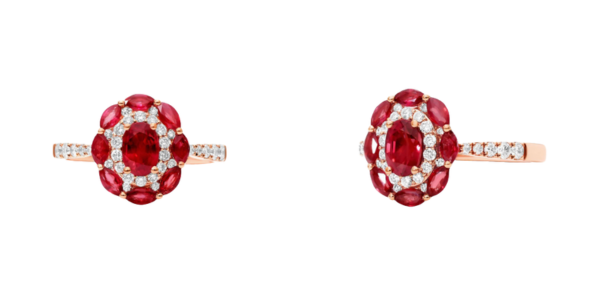
|
| Indulge In Regal Elegance! Click The Image To Explore This Breathtaking Ruby And Diamond Masterpiece In Warm Rose Gold |
In cases where buildup is too thick or has settled into small crevices, a jeweler’s ultrasonic cleaning might be an option. However, this method is not safe for fracture-filled or treated rubies, as vibrations can cause structural issues. If in doubt, consult a professional jeweler before using ultrasonic or steam cleaning methods.
How To Clean Ruby Rings-Why Regular Cleaning is Essential
A ruby’s glow comes from its ability to reflect light, but dirt and oil can dim that sparkle over time. Everyday wear exposes your ring to dust, lotion, and natural skin oils, which gradually coat the gemstone and make it look dull. Without regular cleaning, the brilliance of the ruby ring gets masked under layers of buildup.
A simple at-home cleaning routine helps preserve your ruby’s fiery glow. Washing your ring at least once every two weeks prevents grime from accumulating, making deep cleaning sessions less necessary. A well-maintained ruby retains its vibrancy and remains the centerpiece of your jewelry collection.
Neglecting proper care can lead to long-term issues. When dirt and residue settle into the setting, they can weaken prongs or trap moisture, increasing the risk of damage. Keeping your ruby ring clean isn’t just about looks—it’s about protecting its structure and longevity.
Harmful Cleaning Methods to Avoid
Certain cleaning methods can do more harm than good when cleaning a ruby ring. Harsh chemicals, such as bleach, ammonia, or vinegar, can corrode the metal setting and strip the gemstone’s surface of any enhancements. Even natural acids, like lemon juice, can cause discoloration or weaken treated rubies. Boric acid, sometimes used for gold jewelry cleaning, can etch the ruby’s surface and reduce its brilliance over time.
Scrubbing too aggressively can also damage your ring. While rubies are hard, they are not invincible. Using abrasive pads, stiff brushes, or harsh cloths can create microscopic scratches that dull the surface over time. Gentle cleaning techniques protect both the gemstone and the metal setting.
14K Rose Gold Wavy Ruby and Diamond Ring |
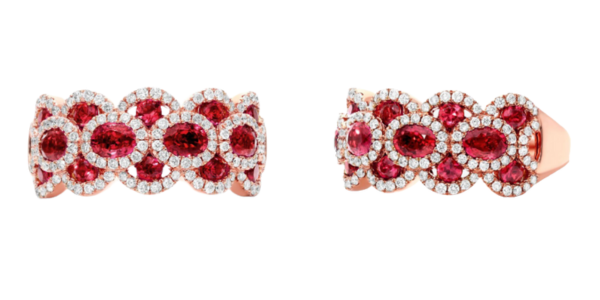
|
| A Wave Of Brilliance Awaits! Tap The Image To See How This Ruby-Studded Beauty Dances With Light |
Ultrasonic and steam cleaning methods should be used with caution. While natural, untreated rubies may withstand these techniques, heat-treated or fracture-filled rubies can suffer internal fractures or lose their enhancements. When in doubt, always choose the safest cleaning method to keep your ruby ring in pristine condition.
Additionally, cleaning near an open drain or basin without a stopper can be risky. A slippery ring can easily fall into the drain, making retrieval difficult or even impossible. To avoid accidental loss, always clean your ruby ring over a secure surface, like a shallow dish or a towel-lined counter.
Section Summary
| Feature | Description |
|---|---|
| Safe Cleaning Routine | A gentle cleaning routine uses mild soap and lukewarm water to protect the ruby and its setting. |
| Step-by-Step Guide | Steps include preparing a cleaning solution, soaking, scrubbing, rinsing, and buffing. |
| Deep Cleaning Options | For stubborn grime, professional cleaners or cautious ultrasonic methods may be considered. |
| Harmful Methods to Avoid | Avoid harsh chemicals, aggressive scrubbing, and risky cleaning techniques that damage the gemstone. |
|
|
2) Understanding Ruby Gemstone Properties: What Makes Cleaning Different?Back To Top |
Rubies are among the hardest gemstones, but their structure and treatments require special care. Unlike diamonds, rubies often undergo enhancements that affect their durability. Cleaning methods must be chosen carefully to preserve their brilliance and longevity.
|
|
2.a) How To Clean Ruby Rings-Why Rubies Require Special CareBack To Top |
Though rubies rank high on the Mohs hardness scale, they are still vulnerable to scratches, chips, and damage. Many rubies on the market receive treatments that can weaken their internal structure. Safe cleaning practices help protect both the gemstone’s natural beauty and any enhancements it may have.
Ruby’s Hardness and Durability
Rubies boast a remarkable hardness of 9 on the Mohs scale, making them one of the most resilient gemstones available. This toughness allows them to withstand daily wear without easily scratching, but they are not indestructible. A strong impact or sudden temperature change can cause internal fractures or weaken the stone’s clarity.
14K Rose Gold Halo Ruby Five Stone Ring |
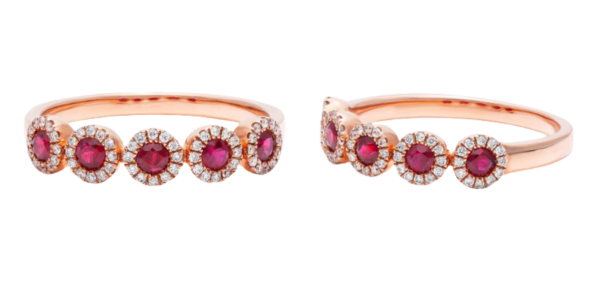
|
| Five Fiery Rubies, One Dazzling Halo—Click Now To Discover This Exquisite Statement Piece In Rose Gold! |
Despite their hardness, rubies can still develop surface abrasions, tiny fractures, or chips over time. Metal settings can press against the ruby’s edges, leading to small nicks that dull its sparkle. Proper storage, careful handling, and gentle cleaning methods help prevent unnecessary damage.
A ruby’s durability depends on its structural integrity. Untreated rubies tend to be stronger, while those with fracture-filling or heat treatment may require extra care. Cleaning methods should always consider the ruby’s specific condition to avoid accidental harm.
How Ruby Treatments Impact Cleaning
Many rubies undergo treatments to enhance their color, clarity, or overall appearance. Some treatments make the gemstone more vulnerable to damage during cleaning, requiring special precautions. The most common enhancements include heat treatment, fracture filling, and diffusion treatment.
Heat-treated rubies remain highly durable, as this process simply improves the stone’s natural color. These rubies can generally withstand standard cleaning methods, such as mild soap and water. However, fracture-filled rubies are a different story. They contain glass-like substances within microscopic cracks, making them extremely sensitive to harsh chemicals, ultrasonic cleaning, and sudden temperature shifts.
Rubies treated with lead-glass filling or diffusion techniques require even more caution. Harsh cleaning methods can strip away treatments, causing the ruby to appear cloudy or even damaged. For these rubies, it’s best to stick to mild soap and warm water, avoiding any aggressive scrubbing. Understanding a ruby’s treatment history is crucial before choosing how to clean it.
Which Cleaning Methods Work Best for Different Types of Rubies?
Different types of rubies require different levels of care. Untreated rubies are the most durable and can tolerate soap, water, and even ultrasonic cleaning if the setting allows it. They have no internal fillings or coatings, making them the easiest to maintain.
14K White Gold Marquise Ruby and Diamond Ring |
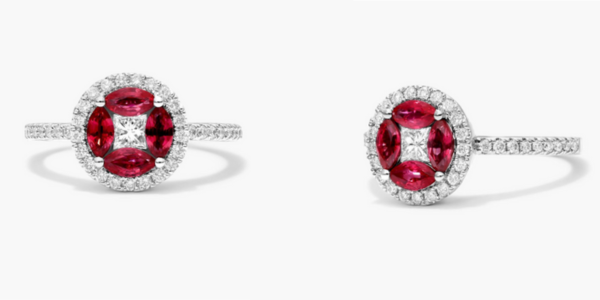
|
| Sleek, Sophisticated, And Timeless! Tap The Image To Experience The Striking Beauty Of This Marquise-Cut Ruby Ring |
Fracture-filled rubies are delicate and require a gentle touch. Even common household cleaners can break down the fillings, making the ruby appear dull or damaged. A simple mix of mild dish soap and warm water is the safest option, along with a soft brush to remove dirt from crevices. Harsh scrubbing should always be avoided.
Heat-treated rubies fall somewhere in between. They can typically handle soap and water cleaning, but it’s best to skip ultrasonic and steam cleaners, as extreme heat can sometimes alter their appearance. Sticking to a mild cleaning routine helps keep their color vibrant without any risk.
The best cleaning approach always depends on how the ruby was treated. If unsure about a ruby’s history, it’s wise to consult a professional jeweler before attempting deep cleaning. Proper care keeps rubies brilliant, durable, and ready to shine for generations.
Section Summary
| Feature | Description |
|---|---|
| Gemstone Properties | Rubies are very hard, yet treatments and enhancements make them sensitive. |
| Cleaning Sensitivity | Their structure demands cleaning methods that preserve both beauty and durability. |
| Treatment Impact | Treatments like heat, fracture filling, and diffusion make some rubies more delicate. |
| Method Variations | Cleaning methods vary for untreated, fracture-filled, and heat-treated rubies. Professional advice is recommended when in doubt. |
|
|
3) Common Mistakes to Avoid When Cleaning Ruby RingsBack To Top |
Cleaning your ruby ring the wrong way can lead to damage, dullness, or even permanent discoloration. Some common cleaning mistakes strip away a ruby’s brilliance rather than restoring it. Understanding which methods are harmful helps you protect your gemstone jewelry.
|
|
3.a) What Not to Do: Cleaning Mistakes That Can Damage Your RubyBack To Top |
Many people assume all cleaning solutions are safe for their ruby engagement ring or jewelry pieces, but that’s far from true. Harsh chemicals, aggressive scrubbing, and prolonged soaking can all weaken the stone’s structure. Knowing how to care for ruby jewelry properly ensures that your ring remains as stunning as the moment you first wore it
Using Harsh Chemicals
Chemicals like bleach, ammonia, vinegar, and alcohol can cause damage to your ruby. These substances can corrode the metal setting and weaken any treatments used to enhance the stone’s color or clarity. Even natural acids, such as lemon juice, can harm rubies by stripping away surface luster and creating unwanted reactions with certain gemstone treatments.
18K White Gold Oval Halo Ruby and Diamond Ring (7.0×5.0mm) |
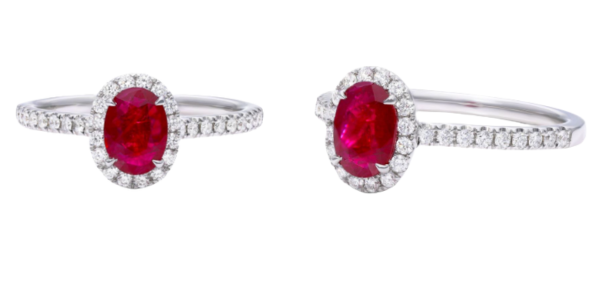
|
| A Halo Of Diamonds Cradles A Stunning Ruby—Click To See This Elegant 18K White Gold Masterpiece Up Close |
Boric acid, often used to clean gold or platinum jewelry, is another chemical to avoid. It can etch the surface of even high-quality rubies, leaving them looking dull or cloudy. Always keep your ruby and sapphire rings away from strong cleaning agents. A simple solution of soapy water is the safest way to maintain these beautiful gemstones without risking damage.
Scrubbing Too Hard
Using too much force when cleaning your ruby engagement ring can leave visible scratches or wear down the stone’s polish. While rubies are one of the hardest gemstones on the Mohs hardness scale, they can still develop small abrasions, especially if cleaned with rough materials. A toothbrush with soft bristles works best for lifting dirt without harming the gemstone’s surface.
Rough scrubbing can also loosen prongs or settings, increasing the risk of losing your stone. The best approach is gentle circular motions around the ruby and its setting. Let the soapy water do the heavy lifting rather than relying on force. A light touch preserves the brilliance of natural rubies without causing unnecessary stress to the jewelry piece.
Soaking the Ring for Too Long
Leaving your ruby ring in water for extended periods can weaken the setting and damage treated stones. Rubies that have undergone fracture filling or lead-glass treatments are especially vulnerable, as prolonged exposure to water can cause fillings to break down. This results in a cloudy or damaged appearance that is difficult to reverse.
Water can also seep into tiny gaps in the setting, loosening the stone over time. Rings with white gold or platinum bands may be at lower risk, but those set in softer metals like silver can suffer from excessive moisture exposure. If you need to soak your ring to remove dirt, limit the time to just a few minutes and dry it thoroughly afterward.
Ultrasonic and Steam Cleaning Risks
While ultrasonic and steam cleaners are effective for some types of gemstone jewelry, they pose serious risks for rubies that have been treated. High heat and vibration can cause damage to the stone, particularly if it has inclusions or has been fracture-filled. The effects of heat on treated rubies can weaken the structure, causing cracks or internal flaws to spread.
18K White Gold Oval Halo Ruby and Diamond Ring (7.0×5.0mm) |

|
| Twice The Brilliance! This Radiant Ruby Ring Is Worth A Closer Look—Tap The Image To Explore Its Beauty |
Untreated stones may withstand ultrasonic cleaning, but it’s always best to examine the stone before exposing it to extreme cleaning methods. If you’re unsure whether your ruby is natural or enhanced, take it to a professional jeweler rather than risking damage. Gentle hand cleaning remains the safest option for maintaining the brilliance and longevity of your ruby jewelry.
Section Summary
| Feature | Description |
|---|---|
| General Cleaning Mistakes | Improper cleaning can dull your ruby’s sparkle and cause permanent discoloration. |
| Using Harsh Chemicals | Bleach, ammonia, vinegar, and alcohol can damage the gemstone and its metal setting. |
| Aggressive Scrubbing | Forceful scrubbing can scratch the ruby and loosen its setting. |
| Excessive Soaking | Prolonged soaking weakens the setting and may damage treated stones. |
| Risky Cleaning Methods | Ultrasonic and steam cleaning can cause fractures or damage enhancements in rubies. |
|
|
4) How to Maintain the Beauty of Your Ruby Ring DailyBack To Top |
Keeping your ruby ring clean and well-maintained ensures it stays brilliant and free from dullness. Daily habits like avoiding harsh chemicals and proper storage can extend the life of your gemstone. With the right care and cleaning routine, your ruby or sapphire jewelry will continue to shine for years.
|
|
4.a) Daily Care Tips for Ruby RingsBack To Top |
A ruby ring is durable, but regular exposure to dirt, oil, and household substances can affect its sparkle. Gentle cleaning, mindful handling, and proper storage are key to keeping your gemstone jewelry in top condition. Simple daily care steps can prevent unnecessary damage and maintain these beauties effortlessly.
How Often Should You Clean a Ruby Ring?
Cleaning your ruby ring at the right frequency helps maintain its natural glow without causing unnecessary wear. A gentle cleaning with soapy water at least once a month is ideal for removing everyday buildup from lotions, perfumes, and sweat. Rings that see heavy use, like engagement rings or heirloom pieces worn daily, may need cleaning every two weeks to keep dirt and oils from dulling the surface.
Deep cleaning should be done every 6-12 months, depending on wear and exposure to elements. If your ruby is fracture-filled or cavity-filled, extra caution is necessary, as prolonged soaking or abrasive scrubbing can weaken the stone’s structure. If you’re unsure about your ruby’s treatment history, consulting a jeweler before deep cleaning can help prevent damage.
Keeping Your Ruby Free from Dirt and Oil
A ruby’s fiery brilliance can quickly fade when covered in a layer of dirt, oils, and product residue. Daily contact with skincare products, household cleaners, and even natural skin oils can create buildup, making the gemstone look cloudy. To prevent this, remove your ring before applying lotions, perfumes, or hand sanitizers. If accidental exposure occurs, a quick rinse under lukewarm water can help reduce buildup.
Emerald Cut Bezel Set Ruby Pave Ring in 14k Rose Gold (1 ct. tw.) |
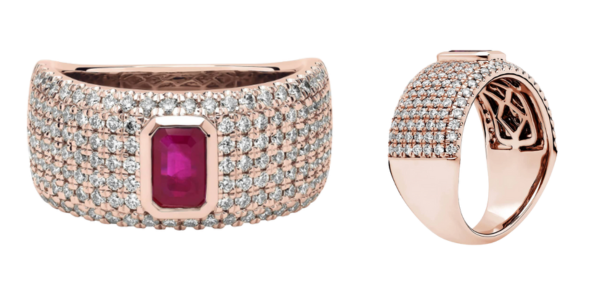
|
| Bold, Modern, And Mesmerizing! Click To See This Emerald-Cut Ruby Shine In A Sleek Bezel Setting |
Keeping your ring away from chemicals is essential. Cleaning agents, chlorine, and even prolonged soap exposure can affect both the gemstone and its setting. A real ruby may resist surface damage, but repeated exposure to harsh substances can weaken gold, platinum, or white gold settings over time. To ensure long-term shine, wiping your ruby ring with a soft cloth after each wear can help maintain its beauty.
Preventing Scratches and Damage
Despite being one of the hardest gemstones on the Mohs hardness scale, a ruby can still be scratched by harder stones like diamonds. Storing diamonds, sapphires and rubies together without protection can lead to minor abrasions that dull their brilliance. To avoid damage, always keep your ruby ring separate from other jewelry pieces, ideally in a soft, fabric-lined pouch or a jewelry box with individual compartments.
Daily wear can also expose your ruby ring to accidental bumps and scratches. Removing your ring before household chores, gym workouts, or outdoor activities can help prevent unnecessary impact damage. If your stone is cavity-filled or has inclusions, sudden impacts may lead to cracks or weakened structural integrity. Careful handling is key to preserving its flawless appearance.
Regular inspections can help detect potential issues before they worsen. Checking for loose prongs, worn settings, or small chips ensures your ruby stays secure in its setting. If you notice any signs of wear, a jeweler’s inspection can provide the necessary repairs to keep your gemstone safe. With consistent care, your ruby ring will remain a dazzling treasure for generations.
Section Summary
| Feature | Description |
|---|---|
| Cleaning Frequency | Clean your ruby ring with soapy water at least once a month. Rings worn daily may need cleaning every two weeks. Deep cleaning every 6-12 months is recommended. |
| Dirt & Oil Prevention | Remove the ring before applying lotions or perfumes. Rinse quickly if it contacts household chemicals to avoid buildup. |
| Preventing Scratches | Store your ring separately to prevent abrasions. Remove it during chores or workouts and inspect for loose prongs or chips. |
|
|
5) Proper Storage Methods for Ruby RingsBack To Top |
Storing your ruby ring correctly protects it from scratches, dullness, and environmental damage. Improper storage can lead to abrasions, weakened settings, or loss of brilliance over time. By following the right steps, you can keep your fine jewelry in perfect condition.
|
|
5.a) Best Practices for Storing Ruby JewelryBack To Top |
A ruby ring needs a designated storage space to prevent damage from other jewelry pieces. Keeping it in a lined jewelry box, away from extreme conditions, preserves its color and shine. Proper storage methods help maintain these beauties so they remain as radiant as the day you got them.
Storing Rubies Separately from Other Gemstones
A ruby may be one of the hardest gemstones, but that doesn’t mean it’s immune to scratches. Diamonds, which rank higher on the Mohs hardness scale, can leave fine scratches on the ruby’s surface if stored together. Even sapphires and rubies rubbing against each other can cause minor abrasions, leading to a loss of polish over time.
Ruby and Diamond Two Stone Ring in 14k Yellow Gold |
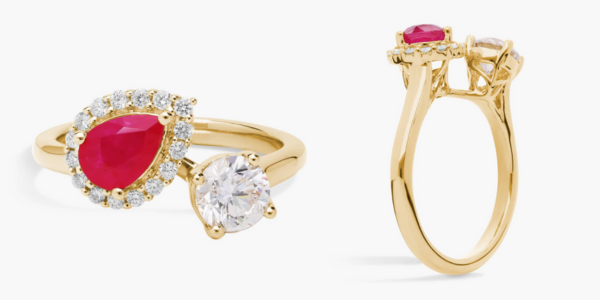
|
| A Symbol Of Passion And Unity! Tap The Image To Uncover The Charm Of This Timeless Two-Stone Design |
To prevent unnecessary damage, always keep your ruby ring in its own compartment or pouch. Storing it separately from other gemstone jewelry ensures that no accidental friction occurs. If you place multiple rings in one box, consider using individual fabric pouches to add an extra layer of protection. Taking these precautions helps keep your ruby ring looking flawless.
Ideal Storage Conditions for Ruby Rings
Rubies can withstand daily wear, but exposure to extreme temperatures, humidity, or direct sunlight can impact their beauty. Leaving your ruby engagement ring on a sunny windowsill or in a hot environment can cause gradual color changes. Humidity can weaken metal settings, making them more prone to loosening over time.
Always store your ruby ring in a cool, dry place where temperature fluctuations are minimal. A jewelry box kept in a bedroom drawer offers better protection than leaving the ring in a bathroom, where moisture levels fluctuate. If your ruby is fracture-filled or treated, extra caution is necessary, as exposure to high heat or chemicals can impact its durability. Keeping your ring away from unstable conditions preserves both the gemstone and its setting.
Using a Lined Jewelry Box or Pouch
A soft, fabric-lined jewelry box is the best place to store your ruby ring when it’s not being worn. Hard surfaces, such as glass or metal, can cause accidental scratches or chips if the ring shifts during storage. A velvet or satin-lined jewelry case cushions the ring, protecting it from impact and preventing unwanted scratches.
For added safety, storing your ruby in a separate cloth pouch can provide extra protection. This is especially useful if you travel frequently or store multiple jewelry pieces together. Keeping your ruby ring in a designated pouch or compartment ensures it remains free from dust, dirt, and potential abrasions. Taking care of storage details today means your ruby ring will stay stunning for years without needing frequent re-polishing or repairs.
Section Summary
| Feature | Description |
|---|---|
| Damage Prevention | Correct storage prevents scratches, abrasions, and loss of brilliance. |
| Separate Storage | Keep your ring in its own compartment or pouch to avoid friction with other jewelry. |
| Optimal Environment | Store your ring in a cool, dry place away from extreme temperatures, humidity, and direct sunlight. |
| Soft Storage Solutions | Use a fabric-lined jewelry box or pouch to cushion your ring and prevent accidental impacts. |
|
|
6) How to Clean Ruby Rings – When to Seek Professional Cleaning for Your Ruby RingBack To Top |
Even with proper care, your ruby ring may lose its brilliance over time. Professional cleaning removes stubborn grime, restores its shine, and ensures the gemstone remains secure in its setting. Knowing when to visit a jeweler helps protect your investment and keeps your ruby jewelry in top condition.
|
|
6.a) Signs Your Ruby Ring Needs Professional Cleaning and MaintenanceBack To Top |
If your ruby looks dull despite regular cleaning, it may need a deeper treatment from a jeweler. Loose prongs, chips, or scratches can weaken the stone’s durability, making professional care essential. Annual inspections help detect minor issues before they become costly repairs.
Cloudiness or Dull Appearance
A ruby’s brilliance comes from its ability to reflect light, but dirt, oil, and product buildup can create a cloudy surface. Regular at-home cleaning helps, but sometimes deeper deposits require professional attention. If soapy water and a soft brush fail to restore your ruby’s sparkle, a jeweler can use ultrasonic or steam cleaning techniques to eliminate stubborn grime.
Some rubies, especially fracture-filled or heat-treated ones, need extra caution. Harsh cleaning can strip away enhancements, leaving the stone looking dull or discolored. Jewelers know how to care for treated rubies without risking damage, making professional cleaning the safest option for long-term maintenance.
Loose Prongs or Settings
A loose setting can turn a beautiful ruby ring into a disaster waiting to happen. Daily wear, exposure to water, and accidental bumps can weaken the metal prongs holding your gemstone in place. If your ruby shifts when touched, or if the prongs appear worn down, take it to a jeweler immediately.
Pear-Shaped Ruby Ring with Diamond Halo in 14k White Gold |
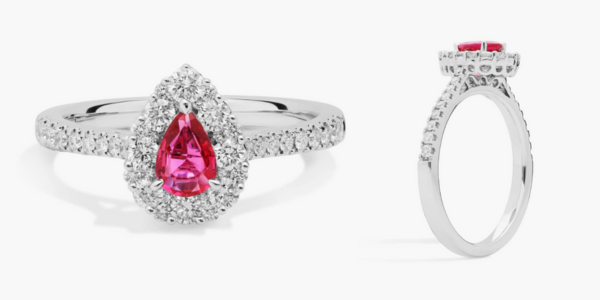
|
| A Drop Of Pure Elegance! Click The Image To Admire This Pear-Shaped Ruby Ring Sparkling With Diamonds |
Ignoring a loose setting can result in losing your gemstone, especially in high-wear jewelry like engagement rings. Jewelers can inspect the prongs, tighten them, and ensure the ruby remains secure. Regular inspections can save you from the heartbreak of losing an irreplaceable stone.
Visible Scratches or Chips
Rubies are tough, ranking high on the Mohs hardness scale, but they aren’t invincible. Over time, even real rubies can develop small scratches or chips, especially if stored with diamonds or other harder gemstones. Minor surface scratches can be polished out, restoring the stone’s shine without altering its shape.
For deeper chips, repolishing or recutting may be necessary. Professional jewelers assess the damage and determine whether the ruby can be buffed or if it needs more intensive repair. Investing in these touch-ups ensures your ruby retains its beauty without compromising its overall value.
Annual Inspections: Why They Matter
Even if your ruby looks perfect, having it professionally inspected once a year is a smart move. Jewelers check for hidden damage, loose settings, and any structural weaknesses that could lead to bigger problems. They can also deep-clean the ring, bringing out the gemstone’s original fire and brilliance.
Annual maintenance extends the lifespan of your ruby ring and prevents costly repairs down the road. Whether you own a vintage piece or a newly purchased fine jewelry item, a professional’s trained eye can catch what you might miss. Taking these small steps ensures your ruby remains a treasured heirloom for years to come.
Section Summary
| Feature | Description |
|---|---|
| Professional Cleaning Benefits | Professional cleaning removes stubborn grime, restores shine, and secures the gemstone in its setting. |
| Cloudiness or Dull Appearance | A lackluster look despite regular cleaning signals that deeper treatment is needed. |
| Loose Prongs or Settings | Loose prongs or worn settings indicate damage that a jeweler should inspect immediately. |
| Visible Scratches or Chips | Surface scratches or chips may require repolishing or repair by a professional. |
| Annual Inspections | Yearly inspections catch hidden damage and help maintain your ruby ring’s lasting brilliance. |
|
|
7) The Impact of Gem Settings on Cleaning and DurabilityBack To Top |
The setting of your ruby ring plays a crucial role in how well it withstands daily wear and cleaning. Some settings offer better protection, while others expose the gemstone to potential damage. Choosing the right setting ensures both longevity and easier maintenance.
|
|
7.a) Choosing the Right Setting for LongevityBack To Top |
Not all ruby ring settings provide the same level of security and durability. A well-chosen setting can protect your gemstone from chips, scratches, and loosening over time. Understanding the strengths and weaknesses of different settings helps you make an informed decision for long-term wear.
Why Bezel Settings Offer the Best Protection
A bezel setting surrounds the ruby with a smooth metal rim, shielding it from accidental impact and reducing exposure to dirt. This design makes it one of the most durable options, ideal for those who wear their rings daily. Unlike prong settings, bezels prevent the ruby from snagging on fabric or getting knocked loose over time.
Cleaning a bezel-set ruby ring is also easier since the enclosed design reduces the chances of dirt accumulating underneath the stone. A quick soak in soapy water followed by a gentle wipe is usually enough to restore its shine. However, because the metal covers more of the ruby, some light reflection may be lost compared to open settings.
Prong Settings: Pros and Cons
A prong setting holds the ruby in place using small metal claws, allowing maximum light exposure for a stunning, eye-catching sparkle. This design enhances the stone’s brilliance but also leaves it more vulnerable to damage. Since prongs are exposed, they can bend or weaken over time, increasing the risk of the ruby coming loose.
Regular inspections are necessary to ensure the prongs remain intact. Cleaning can also be trickier since dirt and debris tend to collect around the open gaps. While prong settings offer an elegant look, they require more frequent maintenance to keep both the gemstone and the setting secure.
How Setting Type Affects Cleaning Methods
Different ring settings influence how you should clean your ruby without causing harm. A bezel setting is easier to clean because it limits dirt buildup around the gemstone, but care should be taken to avoid excessive scrubbing that could loosen the metal frame. A soft cloth or a gentle brush works best.
For prong-set rubies, special attention is needed when cleaning to avoid bending the delicate prongs. Dirt often gets trapped in hard-to-reach areas, requiring a soft-bristled toothbrush or jewelry cleaner designed for fine gemstones. Rings with intricate settings, such as halo or pave designs, may need professional cleaning periodically to prevent buildup from affecting their sparkle.
Selecting the right setting not only enhances your ruby’s beauty but also determines how easy it will be to maintain. A secure setting means fewer repairs, while a well-chosen cleaning method ensures your ring stays brilliant for years without damage.
Section Summary
| Feature | Description |
|---|---|
| Setting Impact | The ring setting influences durability and cleaning ease. Some designs shield the gemstone better than others. |
| Bezel Settings | Bezel settings enclose the ruby, reducing impact and dirt buildup. They offer superior protection and easier cleaning. |
| Prong Settings | Prong settings enhance sparkle but are more vulnerable to damage. They need extra care and frequent checks. |
| Cleaning Methods | Different settings require specific cleaning techniques. Use gentle cleaning for bezel-set rings and extra care for prong settings. |
| Long-Term Maintenance | A secure setting reduces repairs and ensures lasting brilliance. Choose a design that fits your lifestyle. |
|
|
8) Recognizing and Addressing Damage: What to Do If Your Ruby Ring is DamagedBack To Top |
Even the toughest rubies can develop scratches, chips, or other signs of wear over time. Catching these issues early can prevent further damage and costly repairs. Knowing how to assess and address damage ensures your ruby ring remains in perfect condition.
|
|
8.a) Identifying Common Types of Ruby DamageBack To Top |
Scratches, chips, and fractures are the most common forms of ruby damage. While some minor imperfections can be polished out, others may require professional repair. Understanding the severity of the damage helps determine the best course of action for restoration.
How to Tell If Your Ruby is Scratched
Scratches on a ruby often appear as dull streaks that affect the gemstone’s shine. Running a fingernail over the surface can help detect minor abrasions that may not be immediately visible. Fine scratches can usually be buffed out by a jeweler, restoring the stone’s natural brilliance.
Deeper scratches or surface etching may require professional repolishing. Rubies treated with fillers or heat enhancements need extra caution, as improper polishing can strip away their treatments. Regular inspections and gentle cleaning can help prevent scratches before they become noticeable.
What to Do If Your Ruby Ring is Chipped or Cracked
A chipped ruby may lose some of its visual appeal, but in many cases, the damage can be repaired. Jewelers can repolish the stone, smoothing out minor chips without significantly altering its shape. If the chip is deep, the ruby may need to be recut, slightly reducing its size but restoring its brilliance.
Cracks, on the other hand, pose a more serious risk. A visible fracture weakens the stone’s structure and can worsen over time. If you notice a crack, avoid wearing the ring until a professional jeweler assesses the damage. In extreme cases, stone replacement may be the only option to maintain the integrity of the jewelry.
Section Summary
| Feature | Description |
|---|---|
| Scratches | Minor scratches can be buffed out by a jeweler. Deeper abrasions may need professional repolishing. |
| Chips | Small chips are often repairable through repolishing. Deep chips might require recutting to restore brilliance. |
| Cracks | Cracks weaken the ruby’s structure. They need immediate professional assessment and, in severe cases, stone replacement. |
|
|
10) ConclusionBack To Top |
A well-maintained ruby ring retains its beauty, brilliance, and value. By following these cleaning and care tips, you can ensure your ruby ring remains a cherished piece for years. Whether using safe at-home cleaning methods, storing it properly, or seeking professional maintenance, these steps will keep your ruby dazzling. Treat your ruby with care, and it will continue to shine for generations.
See More Ruby Gemstone Articles As Follows
| Ruby | Engagement Rings Ruby |
| Mens Ruby Ring | Ruby Engagement Rings |
| Pigeons Blood Ruby Color | Ruby or Red Garnet |
| Ruby or Pink Sapphire | Mens Ruby Ring |
| Ruby 3 Stone Ring |